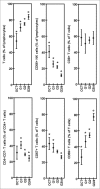Immune signature of tumor infiltrating immune cells in renal cancer
- PMID: 25949868
- PMCID: PMC4368143
- DOI: 10.4161/2162402X.2014.985082
Immune signature of tumor infiltrating immune cells in renal cancer
Abstract
Tumor-associated immune cells have been discussed as an essential factor for the prediction of the outcome of tumor patients. Lymphocyte-specific genes are associated with a favorable prognosis in colorectal cancer but with poor survival in renal cell carcinoma (RCC). Flow cytometric analyses combined with immunohistochemistry were performed to study the phenotypic profiles of tumor infiltrating lymphocytes (TIL) and the frequency of T cells and macrophages in RCC lesions. Data were correlated with clinicopathological parameters and survival of patients. Comparing oncocytoma and clear cell (cc)RCC, T cell numbers as well as activation-associated T cell markers were higher in ccRCC, whereas the frequency of NK cells was higher in oncocytoma. An intratumoral increase of T cell numbers was found with higher tumor grades (G1:G2:G3/4 = 1:3:4). Tumor-associated macrophages slightly increased with dedifferentiation, although the macrophage-to-T cell ratio was highest in G1 tumor lesions. A high expression of CD57 was found in T cells of early tumor grades, whereas T cells in dedifferentiated RCC lesions expressed higher levels of CD69 and CTLA4. TIL composition did not differ between older (>70 y) and younger (<58 y) patients. Enhanced patients' survival was associated with a higher percentage of tumor infiltrating NK cells and Th1 markers, e.g. HLA-DR+ and CXCR3+ T cells, whereas a high number of T cells, especially with high CD69 expression correlated with a worse prognosis of patients. Our results suggest that immunomonitoring of RCC patients might represent a useful tool for the prediction of the outcome of RCC patients.
Keywords: CD13; CD57; CD69; MDSC, myeloid-derived suppressor cells; MFI, mean fluorescence intensity; NK, natural killer cells; PE, phycoerythrine; RCC, renal cell carcinoma; TIL, tumor-infiltrating lymphocytes; flow cytometry; immunohistochemistry; immunophenotype; mAb, monoclonal antibody; oncocytoma; renal cell carcinoma; survival; tumor infiltrating lymphocytes (TIL); tumor-associated macrophages (TAM).
Figures




Similar articles
-
Clinical relevance of miR-mediated HLA-G regulation and the associated immune cell infiltration in renal cell carcinoma.Oncoimmunology. 2015 Mar 2;4(6):e1008805. doi: 10.1080/2162402X.2015.1008805. eCollection 2015 Jun. Oncoimmunology. 2015. PMID: 26155421 Free PMC article.
-
Phenotype, cytokine production and cytolytic capacity of fresh (uncultured) tumour-infiltrating T lymphocytes in human renal cell carcinoma.Clin Exp Immunol. 1997 Sep;109(3):501-9. doi: 10.1046/j.1365-2249.1997.4771375.x. Clin Exp Immunol. 1997. PMID: 9328129 Free PMC article.
-
Flow cytometric analysis of tumour-infiltrating lymphocytes in patients with renal cell carcinoma.Br J Urol. 1997 Oct;80(4):543-7. doi: 10.1046/j.1464-410x.1997.00408.x. Br J Urol. 1997. PMID: 9352689
-
Study of tumor-infiltrating lymphocytes for adoptive therapy of renal cell carcinoma (RCC) and metastatic melanoma: sequential proliferation of cytotoxic natural killer and noncytotoxic T cells in RCC.J Immunother (1991). 1991 Oct;10(5):313-25. doi: 10.1097/00002371-199110000-00003. J Immunother (1991). 1991. PMID: 1790139
-
Tumor infiltrating CD8+ T lymphocyte count is independent of tumor TLR9 status in treatment naïve triple negative breast cancer and renal cell carcinoma.Oncoimmunology. 2015 May 22;4(6):e1002726. doi: 10.1080/2162402X.2014.1002726. eCollection 2015 Jun. Oncoimmunology. 2015. PMID: 26155410 Free PMC article.
Cited by
-
The presence of tumour-infiltrating neutrophils is an independent adverse prognostic feature in clear cell renal cell carcinoma.J Pathol Clin Res. 2021 Jul;7(4):385-396. doi: 10.1002/cjp2.204. Epub 2021 Mar 4. J Pathol Clin Res. 2021. PMID: 33665979 Free PMC article.
-
Natural killer cells in antitumour adoptive cell immunotherapy.Nat Rev Cancer. 2022 Oct;22(10):557-575. doi: 10.1038/s41568-022-00491-0. Epub 2022 Jul 25. Nat Rev Cancer. 2022. PMID: 35879429 Free PMC article. Review.
-
T and NK cell abundance defines two distinct subgroups of renal cell carcinoma.Oncoimmunology. 2022 Jan 4;11(1):1993042. doi: 10.1080/2162402X.2021.1993042. eCollection 2022. Oncoimmunology. 2022. PMID: 35003893 Free PMC article.
-
HLA-I-restricted CD8+ T cell immunity may accelerate tumorigenesis in conjunction with VHL inactivation.iScience. 2022 May 25;25(6):104467. doi: 10.1016/j.isci.2022.104467. eCollection 2022 Jun 17. iScience. 2022. PMID: 35677644 Free PMC article.
-
Establishment of a Prognostic Prediction and Drug Selection Model for Patients with Clear Cell Renal Cell Carcinoma by Multiomics Data Analysis.Oxid Med Cell Longev. 2022 Jan 4;2022:3617775. doi: 10.1155/2022/3617775. eCollection 2022. Oxid Med Cell Longev. 2022. PMID: 35028006 Free PMC article.
References
-
- Kuroda N, Toi M, Hiroi M, Shuin T, Enzan H. Review of renal oncocytoma with focus on clinical and pathobiological aspects. Histol Histopathol 2003; 18:935-42. Available from: http://www.ncbi.nlm.nih.gov/pubmed/12792905; PMID: - PubMed
-
- Silverberg E, Lubera J. Cancer statistics. CA Cancer J Clin 1987; 37:2-19. Available from: http://www.ncbi.nlm.nih.gov/pubmed/3099992; PMID:; http://dx.doi.org/10.3322/canjclin.37.1.2 - DOI - PubMed
-
- Russo P. Renal cell carcinoma: presentation, staging, and surgical treatment. Semin Oncol 2000; 27:160-76. Available from: http://www.ncbi.nlm.nih.gov/pubmed/10768595; PMID: - PubMed
-
- Motzer RJ, Basch E. Targeted drugs for metastatic renal cell carcinoma. Lancet 2007; 370:2071-3. Available from: http://www.ncbi.nlm.nih.gov/pubmed/18156012; PMID:; http://dx.doi.org/10.1016/S0140-6736(07)61874-1 - DOI - PubMed
-
- Whiteside TL. Immune suppression in cancer: effects on immune cells, mechanisms and future therapeutic intervention. Semin Cancer Biol 2006; 16:3-15. Available from: http://www.ncbi.nlm.nih.gov/pubmed/16153857; PMID:; http://dx.doi.org/10.1016/j.semcancer.2005.07.008 - DOI - PubMed
LinkOut - more resources
Full Text Sources
Other Literature Sources
Medical
Research Materials
Miscellaneous
